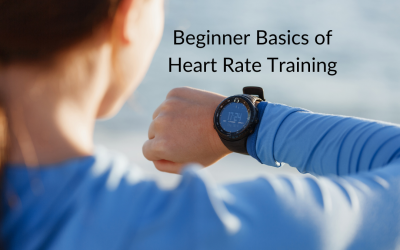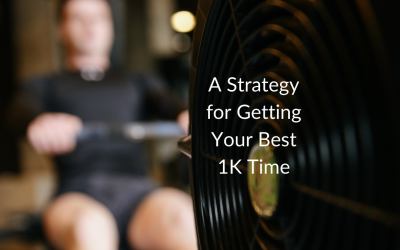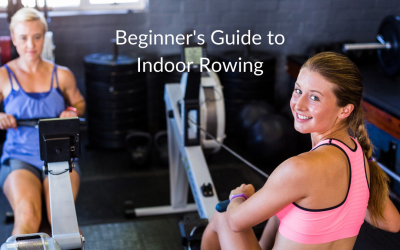How to Use Stroke Rate to Your Advantage
Whether you row in your garage or in a gym, there’s a number on that monitor that you should be paying attention to. And that’s your stroke rate!
Most people are only concerned about the split that they are pulling. While that number is very important, it shouldn’t be the only one you’re looking at.
Your stroke rate is denoted s/m on the monitor, or strokes per minute. This is how fast you’re moving in space. So 30 s/m means you will take 30 strokes every minute at that speed you are moving back and forth.
Here’s the kicker. Having a higher stroke rate doesn’t always mean you’ll have a faster split. In some cases, I think it actually causes you to go slower.
HIGHER ISN’T ALWAYS BETTER
Having a higher stroke rate means you will take another stroke faster. While it is important to keep that flywheel spinning, if you’re not applying power on your drive your split will still be slower than it could be.
Picture this: Person #1 is moving back and forth quickly on the machine, at 35 s/m. Their drive and recovery are about the same length of time, and they aren’t getting much power into the machine.
Person #2 is holding 25 s/m. Their drive is much faster than their recovery. In fact, they have time to breathe on the way up. Because their drive is so much faster, they are putting more power into the machine. Their split is much faster.
This example shows how your ratio is important. In rowing, when referring to ratio it’s the ratio of your drive time to recovery time. So a 1:2 ratio has your recovery twice as long as your drive.
If one person slams back and forth on the machine and doesn’t apply their power INTO the machine, their split will be slower than if they had a hard drive, and took their time on their recovery.
A ratio of 1:2 is ideal but will get a little fuzzy as the stroke rate increase. As long as the drive stays faster than the recovery you will be in good shape.
This is a prime example of when a higher stroke rate isn’t always better. On the flip side, trying to row at the lowest stroke rate possible will also make it hard to pull the fastest splits because the flywheel slows down too much. It’s all about balance.
FIND BALANCE BETWEEN STROKE RATE AND INTENSITY
If rowing at the highest stroke rate possible isn’t the best, and rowing at the slowest stroke rate possible isn’t that best, then what is? Well, that will depend on the person, and the piece you’re trying to row.
That sounds complicated, so hopefully, these tips will help with different kinds of rowing pieces. Keep in mind these ranges are approximate, so if you don’t exactly fit in these ranges that is perfectly ok. I find these are some good guidelines to start out with if you have no idea where to start.
Long, steady-state rows: These will be lower stroke rates, about 18-24 depending on the length of time. Any higher and you will probably tire out too quickly. These pieces should feel like you have a relaxed recovery while still keeping a strong drive.
Longer, hard pieces: For pieces anywhere from about 4-10 min long will require a slightly higher stroke rate to keep the intensity high. Somewhere from 24-28 s/m. This allows you to push yourself to get a faster split, but also manage your aerobic capacity.
Longer sprint pieces: These may be pieces that are approx 2-4 min long. You may be somewhere between 26-32 spm. These pieces typically give you enough rest in between to let your heart rate come down (at least 2 min rest) so you can have a higher stroke rate to keep that flywheel spinning but still recover between each piece.
Short sprint pieces: Anything less than 2 min long will probably be a higher stroke rate around 28-34 s/m.
Keep in mind, all of these ranges assume that your drive is faster than your recovery. You may be on the lower end of each stroke rate range if you are a newer rower.
With each type of piece, the goal is to balance your stroke rate with the split you want to hold during that duration of time. Longer pieces make it hard to keep a high stroke rate because you get tired much quicker. Shorter pieces can allow you to have higher stroke rates because you get rest in-between.
You can use your stroke rate, how long your piece is, and how much is left in your tank to find that perfect combo of all three to push yourself. Don’t be afraid to adjust your stroke rate during the middle of the piece to accommodate how you’re feeling.
JUDGE YOUR TANK LEVEL, AND ADJUST
Making stroke rate changes during a piece will depend on how you’re feeling during it.
Higher stroke rates challenge your aerobic capacity, even if you’re not pulling as hard. The fact that you are moving faster back and forth uses more energy!
It IS possible to lower your stroke rate and keep the same split. This takes a lot of practice.
If you are doing longer pieces, and you feel yourself starting to slip on the intensity you can hold, it may be a good idea to lower your stroke rate by lengthening your recovery. Even one or two beats will make a difference over time.
The opposite is true if you’re feeling good! First go for a faster split at that same stroke rate, but if that’s not working you can bump up your stroke rate by a beat or two if you think you can handle it. If it ends up being too much, you can always bring that stroke rate back down.
ONE EXCEPTION
There is one exception to the rule when I say “higher stroke rate isn’t always better”. And that’s when you’re at the end of a testing piece.
So if you’re doing a 2k and you have 200m to go, there’s close to no energy left in your tank, crank up that stroke rate to get it done!
Learning to use stroke rate to your advantage is a skill that takes a long time to master in rowing. First, you need to know your own limits, and you’re not going to know what those are until you test them!
There will be many days where you think “I should’ve used a slower/faster stroke rate”. Use those days to learn more for next time! We are all constantly learning about how we can best push ourselves in our rowing. It’s going to look different for everyone.
Beginner Basics of Heart Rate Training in Rowing
You may read heart rate training and think you need to start paying attention to all these numbers or buy all of the things to track your heart rate. While you can buy some gear to help you accomplish heart rate training, it’s not required. Sure, the gadgets will help...
A Strategy for Getting Your Best 1k Time
With the World Rowing Virtual Indoor Rowing Sprints just around the corner, I’m dropping some tips to get a better 1K time. The first bit I harp on a lot. Having good technique will help you get faster, but this doesn’t come overnight. However, there are other things...
Beginner’s Guide to Indoor Rowing
Getting a new workout machine is much like getting a new toy on Christmas. There’s so much excitement and anticipation to try it out! Many times we play with that new toy for a couple of days, and then it’s out of sight and out of mind. My guess is that’s not how you...



